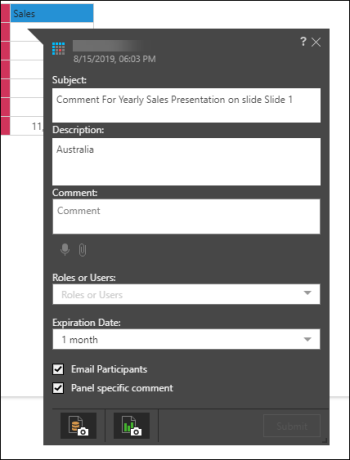The workflow and/or conversation tools allow users to add actionable annotations to reports.
- If using the built-in conversations tool - these are threaded commentary and a chat-style experience
- If using a custom workflow - these are multi-step workflow experiences as designed by a developer
Workflows vs Conversations
Custom Workflows in Pyramid are generic mechanics to annotate data points, hierarchy members and reports. The workflow can then be used to attach some type of content or "payload". The workflows are open capabilities in to which developers can use to build their own mini workflow apps. Conversations are a specific workflow type, that allow users to write comments in conversation threads with other users. The conversation framework is included in the application out-of-the-box.
- Click here for a more in-depth review of Workflows and Conversations,
Triggering a Workflow or Conversation
You can start a new workflow in both Discover and Present.
Present workflows may created at the panel, member, or cell level:
- Report level : a workflow based on the given presentation slide.
- Member level : a workflow based on a given member in the visual.
- Cell level : a workflow based on a given cell (data point) in the visual.
A workflow may be panel-specific or global:
- Report specific : the workflow is linked to the specified member or cell in the given visual in the given presentation only. When creating a panel level item, it is panel-specific by default. To create a report specific item, select 'Report specific comment' from the New workflow panel.
- Global : the workflow is linked to the specified member or cell across the data model. The workflow can be opened from any visual containing the given member or cell, in both Discover and Present. To create a global workflow, deselect 'Report specific comment' from the New WorkFlow panel.
Enable Workflows
There are three ways to enable workflows in Present. Note that workflows can only be enabled when your presentation is launched in runtime.
- Right click on a member or cell and select "Start New Conversation" to open the New Conversation dialog . If there are custom workflows, the choice becomes "Workflows", followed by the choice of the custom workflows or conversations.
- Toggle the conversations icon
 in a visual's panels to show or hide that visual's conversations. Right click on a cell to start a conversation or open an existing one.
in a visual's panels to show or hide that visual's conversations. Right click on a cell to start a conversation or open an existing one. - Right click on the report slide and select Show Conversations open the Conversations panel
- Open the Presentation Menu and toggle Conversations on to open the Conversations panel
Start a Workflow or Conversation
To enable custom workflows or conversations in Present, open your presentation in runtime. Right click on a member or cell in a visualization, and from the context menu click Start New Conversation. If there are custom workflows, the choice becomes "Workflows", followed by the choice of the custom workflows or conversations.

Alternatively, open the Workflows panel in one of the ways listed above. From the Workflows panel and you can start a new workflow. You can also filter by type to show or hide:
- Global workflows
- Workflows started in Discover
- Workflows started in Present
Click here for details about filling out the New Conversation dialog.
Conversation Specifics
Voice Messages and Attachments
You can record a voice message and attach files and images and send them in the conversation thread.
- To record a message, click the microphone icon. Click here for more information.
- To attach a file, click the paperclip icon, then find and select the required file from its folder location. The file will be loaded above the text box, and will be sent when you click Send.
Manage Present Workflows
Because workflows are applied to the given assets, a workflow that was started in Present can also be opened in Discover. For instance, a global cell level conversation started in Present will be accessible everywhere that cell appears (in any visual containing that cell) in both Discover and Present. To learn about managing workflows and conversations from Discover, click here.
Open an Existing Workflow in Present
To open an existing workflow, launch the presentation in runtime. Open the Presentation Menu and toggle Workflows to on. From the panel, filter by level and type:
- Global
- Discover specific
- Present specific
Click on a workflow to open it.

Workflows Panel
The level of workflows listed in the panel are denoted by their icon:
-
 Report level
Report level -
 Member level
Member level -
 Cell level
Cell level
Workflows in the panel are also color coded according to type:
- A red bar represents report-specific workflows
- A green bar represents discover-specific workflows
- A yellow bar represents global workflows
Leave a Workflow
To remove yourself as a participant from a workflow, open the workflow click the its context menu ( three ellipses), and click Leave.
Workflows Feed
You can access your workflows from the Workflows Feed. Click here to learn more.